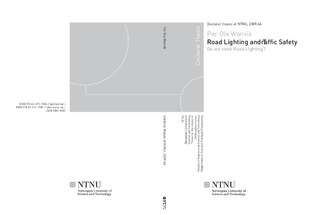| dc.description.abstract | Road lighting is widely recognised as an efficient traffic safety measure. However, we know too little about the effect of road lighting on accidents in a given situation and we do not know what kind of lighting that is optimal for the situation. Society today has a demand for energy savings, locally and globally, and we should not use more energy for road lighting than is necessary. In the field of road lighting the demand for energy savings is accompanied by a fast development of techniques and equipment that give great opportunities for energy savings. The opportunity already exists to adapt the lighting to the actual road, traffic and weather situation. It is a problem, however, that we do not know what lighting quantity and quality which gives the best benefit – cost ratio. The objective of this thesis is to contribute to more knowledge about the relationship between road lighting and traffic safety and thus make a basis for benefit – cost calculations (including environmental costs).
The thesis is based on four studies about the safety effect of road lighting, reported in four papers. The first is a literature study, the second is a Norwegian before-and-after study, the third is a cross-section study of Dutch accidents and the fourth is a study of Dutch motorway accidents. The thesis also contains three appendices presenting some more details from the studies than were shown in the papers. The content of the four papers are presented and discussed as a whole in a (fairly comprehensive) introductory part consisting of 10 chapters, where conclusions about the safety effect are discussed and summarised. The thesis in addition discusses the benefit – cost ratio of road lighting, but it is not treated in any of the papers. It has been useful to discuss this matter in advance of the discussion of the future role of road lighting.
In the literature study (Paper I), the mean effect of road lighting on injury accidents during darkness was found to be -30 %. The mean effect on fatal accidents was -60 %. The mean effect on pedestrian injury accidents was -45 %, and on motorways the mean effect on injury accidents was -50 %.
In the Norwegian before-and-after study (Paper II), the estimated effect of road lighting on injury accidents during darkness was -28 %. The estimated effect was larger at high speed limits than at low speed limits. The estimated effect was smaller on roads with AADT (average daily traffic volume) > 8000 vehicles than on roads with AADT < 8000 vehicles.
In the cross-section study of accidents on all Dutch roads (Paper III), the mean effect of road lighting on injury accidents during darkness was found to be -50 %, while it was -54 % when only rural roads were considered. The effect on pedestrian, bicycle and moped accidents was larger than the effect on automobile and motorcycle accidents, and the differences were statistically significant. There was no significant difference between the safety effects for different accident types (Rear end collisions, Frontal collisions etc.) and no significant difference between the driver age groups 60 – 74 years and 30 – 39 years. The effect on fatal accidents was found to be slightly larger than the effect on injury accidents. The mean effect on twilight accidents was 2/3 of the effect during darkness.
In the study of motorway accidents (Paper IV), the effect on injury accidents during darkness was found to be -49 % on Dutch motorways, while the effect seemed to be much smaller on British and Swedish motorways.
On Dutch rural roads and Dutch motorways, the estimated effect of road lighting on accidents during darkness was smaller during adverse weather and road surface conditions than in fine weather and dry surface conditions. The differences were statistically significant. In fog, there was found no effect of road lighting during darkness. However, there were indications on a daylight safety effect during fog, possibly due to guidance from light poles.
The results from the studies described in this thesis give a basis for increasing the application of road lighting as a traffic safety measure worldwide. Cost – benefit calculations indicate that road lighting is one of the most efficient road safety measures available. However, the energy consumption related to road lighting is a problem that must be considered. The great challenge is to reduce the energy consumption as much as possible without reducing the safety benefit too much.
Future road lighting will probably be of the adaptive type, and it will be essential to know how the safety effect varies according to traffic and weather conditions and how it varies with the road lighting level and the quality of the lighting. The thesis answers some question about the safety effect during different weather conditions. There is, however, too little information about safety effect related to varying road and traffic conditions.
A more serious lack of knowledge is that we do not know how the safety effect varies according to the lighting level. It is not possible to balance the energy consumption and the safety effect as long as this relationship is not known. | nb_NO |
